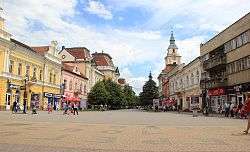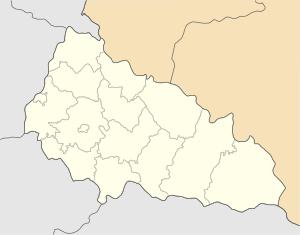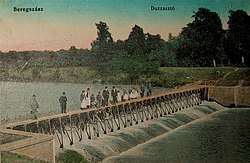Berehove
Berehove or Beregovo (Ukrainian: Берегове; Russian: Берегово; Hungarian: Beregszász; Yiddish: בערעגסאז Beregsaz, Rusyn: Берегово) is a city located in Zakarpattia Oblast (province) in western Ukraine, near the border with Hungary. Population: 24,038 (2016 est.)[1] It is the cultural centre of the Hungarian minority in Ukraine.
Berehove Beregszász • Берегове Берегово • בערעגסאז | |
|---|---|
 Scene of downtown Berehove | |
 Flag  Coat of arms | |
 Berehove Location of Berehovo  Berehove Berehove (Ukraine) | |
| Coordinates: 48°12′20″N 22°38′50″E | |
| Country | |
| Oblast | |
| Raion | City of Berehove |
| Incorporated | 1945 |
| Government | |
| • Mayor | Zoltán Babiák |
| Area | |
| • Total | 19 km2 (7 sq mi) |
| Elevation | 115 m (377 ft) |
| Population (2016) | |
| • Total | 24,038 |
| • Density | 1,371.05/km2 (3,551.0/sq mi) |
| Time zone | UTC+2 (EET) |
| • Summer (DST) | UTC+3 (EEST) |
| Postal code | 90200 |
| Area code(s) | +380-3141 |
| Climate | Cfb |
| Website | http://www.bereg.net.ua/ |
Serving as the administrative center of Berehove Raion (district), the city itself is also designated as a city of oblast significance, with a status equal to a separate raion. It was the capital of the Kingdom of Hungary's Bereg County until 1919 and between 1938–1944. From 1919 until 1938 it was part of Czechoslovakia.
Name
The city has many different variations of spelling its name: Romanian: Bereg, Rusyn: Берегово (translit. Berehovo), Russian: Берегово (translit. Beregovo), Czech and Slovak: Berehovo, Yiddish: בערעגסאז, Beregsaz, German: Bergsaß, Polish: Bereg Saski.
Residents of Berehovo voted on October 31, 2010 in a referendum on renaming the town to Beregszász, its Hungarian-language name.[2][3] Voter turnout was less than 52%, with 4,688 voting for renaming, 4,358 against, and 1,016 invalid ballots.[4]
Administrative division
Part of the city is also a near adjacent village of Zatyshne of 504 people that has its representation in the city's council.
Hungarian has been made a regional language in Berehovo in September 2012; meaning it will now be used in the town's administrative office work and documents.[5] This was made possible after new legislation on languages in Ukraine was passed in the summer of 2012.[5]
Climate
Berehove has an oceanic climate (Köppen: Cfb).
| Climate data for Berehove | |||||||||||||
|---|---|---|---|---|---|---|---|---|---|---|---|---|---|
| Month | Jan | Feb | Mar | Apr | May | Jun | Jul | Aug | Sep | Oct | Nov | Dec | Year |
| Daily mean °C (°F) | −2.4 (27.7) |
−0.2 (31.6) |
4.7 (40.5) |
10.7 (51.3) |
15.6 (60.1) |
18.5 (65.3) |
20.1 (68.2) |
19.7 (67.5) |
15.8 (60.4) |
10.4 (50.7) |
4.9 (40.8) |
0.3 (32.5) |
9.8 (49.6) |
| Average precipitation mm (inches) | 45 (1.8) |
38 (1.5) |
39 (1.5) |
46 (1.8) |
69 (2.7) |
86 (3.4) |
74 (2.9) |
68 (2.7) |
48 (1.9) |
44 (1.7) |
51 (2.0) |
58 (2.3) |
666 (26.2) |
| Source: Climate-Data.org[6] | |||||||||||||
Demographics
In 1910, out of 12,933 inhabitants 12,432 were Hungarians (96.1%), 221 Ukrainians (Ruthenians) and 140 Germans.[7]
The current estimated population is around 26,100 (as of 2005).
In 2001, ethnic groups included:[8]
- 48.1% Hungarians 12.8 thousands
- 38.9% Ukrainians 10.3 thousands
- 6.4% Romani people 1.7 thousands
- 5.4% Russians 1.5 thousands
Prior to World War II, the city had a significant Jewish population, estimated at 8,000 persons. Only four returned, following the war.[9]
The first Hungarian-language college in Ukraine is in Berehovo, the II. Rákoczi Ferenc College. [10]
Notable citizens
- Rabbi Hugo Gryn (1930–1996) was born here on June 25, 1930 and became well known as a broadcaster in Britain.
- The parents of Nobel Prize–winning economist Milton Friedman lived there before emigrating to the United States.
- Julius Rebek (born April 11, 1944), American chemist and expert on molecular self-assembly was born here.
- Csaba Czébely (born December 3, 1975), the drummer of Hungarian heavy metal band Pokolgép.
- Géza Kalocsay (born May 30, 1913, died September 26, 2008), former Hungarian and Czechoslovak footballer, football manager e.g. Standard Liège, FK Partizan, Górnik Zabrze.
- Aranka Siegal (born June 10, 1930) is a writer, Holocaust survivor, and recipient of the Newbery Honor and Boston Globe-Horn Book Award, both awarded to her in 1982.
- Andrea Bocskor (born August 11, 1978[11]), politician who in the 2014 European Parliament election in Hungary was elected into the European Parliament.[12] Hence, Bocskor became the first elected Ukrainian citizen in the European Parliament.[12]
- Yoram Chaiter, physician and cancer researcher was born in the city.
- Hungarian voice actor Gábor Seder was born in Berehove.
- Sári Fedák (1879-1955), Hungarian actress and singer was born here.
- Alen Panov (1978), Ukrainian diplomat, lawyer and professor of Uzhhorod National University
International relations
Twin towns — Sister cities
Berehove is twinned with:
 Jewish mikve in Berehove
Jewish mikve in Berehove The dam in Berehove Postcard 1900
The dam in Berehove Postcard 1900- City limit sign, in three scripts, two languages
References
- "Чисельність наявного населення України (Actual population of Ukraine)" (PDF) (in Ukrainian). State Statistics Service of Ukraine. Retrieved 19 July 2016.
- Information by Fedir Shandor, the Head of the Carpathian Polling Research Center according to Ukrainian Radio website Archived 2010-11-25 at the Wayback Machine
- Берегсас вместо Берегово (GLAVRED: Beregszász instead of Berehove) November 5, 2010
- Romanian becomes regional language in Bila Tserkva in Zakarpattia region, Kyiv Post (24 September 2012)
- "Climate: Berehove". Climate-Data.org. Retrieved 18 April 2014.
- (Hungarian) Szarka László. "A városi magyar népesség a Magyarországgal szomszédos országokban (1910-2000)" (PDF). p. 201. Retrieved 2008-06-25.
- "Ukraine population census 2001". Rebek. Archived from the original on 2015-04-02. Retrieved 2015-03-21.
- Jim Bawden, "Auschwitz twin confronts past". Toronto Star, March 5, 2001: C7.
- https://www.slovoidilo.ua/2017/09/26/infografika/polityka/skilky-ditej-ukrayini-navchayutsya-movamy-naczionalnyx-menshyn
- Andrea BOCSKOR, European Parliament
- (in Ukrainian) A citizen of Ukraine has become a Member of European Parliament, Ukrayinska Pravda (3 July 2014)
External links
| Wikimedia Commons has media related to Berehove, Zakarpattia Oblast. |
- City of Berehove official website (Ukrainian)
- City of Bereghovo official website (English Version)
- Berehove in the Encyclopedia of Ukraine
- Berehove - Shtetlink